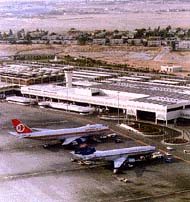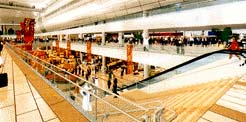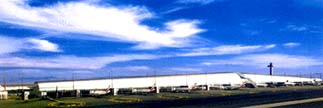
|
|
The airport, already among the most modern and people friendly in the world, is now going ahead with a US $500 million expansion to cope with the 40 percent rise in passengers that is expected over the next ten years. "This expansion will change the face of travelling in the region," claims Mohi Din Binhendi, Director General of the Department of Civil Aviation in Dubai, "The style of the expansion, is in itself, original. It's something totally new," he says. The most impressive part of the development will be the new 800m long, futuristic concourse. Designed to incorporate 28 gates with air bridges, and provision for doubling that capacity should it be needed, this new concourse will be the focal point on which the complete expansion plan for the airport will rest. The concourse will also have 160 ticketing and check-in counters and nine baggage claim carousels. Also planned is a 100 room luxury hotel with full business and conference facilities, a health club, swimming pool and a family entertainment centre. A new control tower will also be built. But, perhaps the most exciting change for passengers, after the brand new concourse, will be the quadrupling in size of the award winning Duty Free area.
A flip side to this is the consolidation in aircraft movements. According to Neil Brownrigg, vice president and program manager for International Bechtel, designers and managers of the expansion. "While traffic growth is increasing between 15-20% annually, the actual number of operations may be smaller since larger aircraft are used." This large aircraft usage is expected to surge with the new generation carriers including the Boeing 777, the new Boeing 747 and Airbus' new long range fleet, all of which can be handled at the airport.
The expansion itself is expected to be carried out in two phases. The first phase, currently underway and due for completion in mid-1999, will include the new concourse, gates and airbridges, the control tower, hotel and duty free. During the course of this construction, the airport, says Binhendi, will close down one of its two runways, since one runway can handle the present level of operations. A third runway, to be added some time before 2010, will be able to handle the Super Jumbo, when it becomes operational. According to sources, the second phase will include the addition of another 28 gates, almost doubling the present expansion. That however, should only begin sometime after 2005. Among the not so visible changes will be completely new baggage handling and information systems and an extension of the 'meet and greet' operations. "All of this," says Binhendi, "is designed to ensure that the average time a traveller takes to complete formalities on arrival or departure will be around fifteen minutes." To do that, an advanced smart security system will also be put in place throughout the airport, it will be able to check all traffic both overtly and covertly. "With the present airport, we have reached saturation point," says Binhendi. "With this current expansion, we should be good for the next 30 years." The full costs of the expansion will be funded by the Dubai Government. Perhaps the most critical question for Dubai Airport is the limited land resources available at the present site. By any reckoning, the massive growth of Dubai has converted this once out of the city site into what is now, almost a downtown location. The present expansion drive in both phases, coupled with the recently announced Dubai Airport Free Zone (DAFZ), is expected to fill the present acreage. But according to Binhendi, the government have realised that at some time in the future Dubai will need a second airport, and has already earmarked land for it. A second airport is still quite a long way off yet, as some industry experts predict that the present location of the airport could handle upto 30 million passengers. The fact that the airport is right within city limits is also a key attraction, cutting down on travel time and sparing passengers long and expensive taxi journeys. In the meantime, the DAFZ project, expected to become operational by autumn 1996, has already received serious enquires. This two million sq.mt facility will cater to hi-tech industries, distribution centres and courier firms; all of whom use air cargo as their major mode of transportation. "The DAFZ will not be competing with Jebel Ali Free Zone. Rather it will complement it and provide better facilities for Dubai," explains Dr. Ahmed Mohammed Zarawani of the Department of Civil Aviation (DCA), which is managing the project. The bays for aircraft have already been built along with the roads for the area. According to Zarawani, land preparation is underway and firms are expected to be ready to move in this year. 70 applications have already been received and the DCA is vetting them to see who would best fit their intended profile of tenants for the zone. "The response to the free zone has been excellent," claims Binhendi. "The fact that an airport has a free zone is not in itself a new idea and we have ample space on the North Side for the zone." One of the already announced tenants is DHL, who will have a state of the art US$4 million facility in the DAFZ. This is expected to become the operations centre for DHL in the UAE and some of the Gulf states. FedEx too, have announced plans for their entry into the zone. Other couriers like Air Express International and Aramex have also expressed serious interest in the new zone and should, in all probability, be among some of it's earliest tenants.
And with Dubai positioning itself as a tourism and conference venue, Dubai airport is placed even more in the spotlight. It's major competitors in the region are Bahrain and, to some extent, now peaceful Beirut. But Dubai sees no threat from either, to its position as the premier airport in the region. "You have to remember that when there is no competition there is no motivation," argues Binhendi. "Everyone competes in the airport business. You have to offer a better service, security systems and all round facilities. That's how standards are raised. We are going for parallel growth in business and tourism." In many ways, that is exactly what would be expected. For in a region with a tendency for tension, Dubai could be in a vulnerable if it promoted itself exclusively as a tourist destination. It will be interesting to see whether Dubai has got it right and the investment will pay off. What is clear is that by the year 2000, Dubai will have created what will be the most integrated airport in the region. "Modestly speaking," remarks Binhendi, "If you combine the business opportunities in Dubai and the environment; there really is no competition."
|
Fergi Varghese |

 Being the third, and biggest, major expansion in the airport's twenty five year history, the increasing need to expand came as a surprise to many. "We didn't have much of a choice," says Binhendi. "Every projection on which the airport's previous expansions were based were exceeded way ahead of schedule. When the first airport was built in 1971, the projection was for between 750,000 to 1.2 million passengers. But we had underestimated just how rapidly we would grow; there was an increase of 800% in traffic between 1971 and '75. The next projection was for 6.1 million passengers, and we expanded the airport accordingly in 1986. That figure has also gone out of the window with current traffic at 7.1 million. The new projection is for 12 million while the airport should be able to handle upto 17 million." This latest expansion is expected to provide for operations until 2015. The projections themselves were done initially by DNATA (Dubai National Air Travel Agency), the handling agency for Dubai Airport, then checked by Bechtel and compared to IATA projections.
Being the third, and biggest, major expansion in the airport's twenty five year history, the increasing need to expand came as a surprise to many. "We didn't have much of a choice," says Binhendi. "Every projection on which the airport's previous expansions were based were exceeded way ahead of schedule. When the first airport was built in 1971, the projection was for between 750,000 to 1.2 million passengers. But we had underestimated just how rapidly we would grow; there was an increase of 800% in traffic between 1971 and '75. The next projection was for 6.1 million passengers, and we expanded the airport accordingly in 1986. That figure has also gone out of the window with current traffic at 7.1 million. The new projection is for 12 million while the airport should be able to handle upto 17 million." This latest expansion is expected to provide for operations until 2015. The projections themselves were done initially by DNATA (Dubai National Air Travel Agency), the handling agency for Dubai Airport, then checked by Bechtel and compared to IATA projections. Interestingly enough, the introduction of long haul aircraft is not expected to decrease transit traffic at the airport. "Earlier when the 747 was introduced, many thought that long haul aircraft would overfly the Gulf countries," said Brownrigg. "That hasn't happened." Ironically, transit traffic through Dubai has increased rapidly and now, according to Binhendi, stands at 35% of total traffic. For that reason alone, the building of a hotel within the complex with full business facilities makes good business sense.
Interestingly enough, the introduction of long haul aircraft is not expected to decrease transit traffic at the airport. "Earlier when the 747 was introduced, many thought that long haul aircraft would overfly the Gulf countries," said Brownrigg. "That hasn't happened." Ironically, transit traffic through Dubai has increased rapidly and now, according to Binhendi, stands at 35% of total traffic. For that reason alone, the building of a hotel within the complex with full business facilities makes good business sense.  The Dubai Cargo Village, part of the Airport, is also expanding. A major feature of the expansion will be semi-automating the facilities within the Village to speed up processing. This will be done by separating the internal administrative processing into two distinct lines, one for incoming and the other for outgoing goods. This upgrading should begin soon. Also on the cards is a new 85,000 sq.ft Agents' building to meet rising demand for space from cargo handlers.
The Dubai Cargo Village, part of the Airport, is also expanding. A major feature of the expansion will be semi-automating the facilities within the Village to speed up processing. This will be done by separating the internal administrative processing into two distinct lines, one for incoming and the other for outgoing goods. This upgrading should begin soon. Also on the cards is a new 85,000 sq.ft Agents' building to meet rising demand for space from cargo handlers.